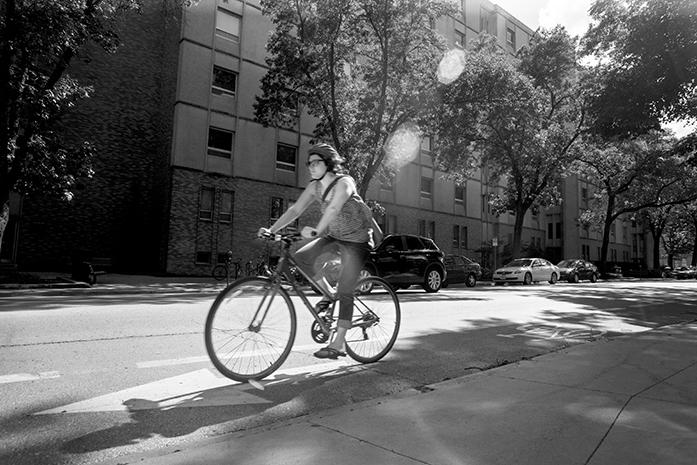It would be hard to ignore the new bike-rack infrastructure that has recently popped up at Dubuque and Washington, and I believe that is precisely the effect the OPN architects were going for when constructing the new design called “PLAY.” The colorful collaboration is the brainchild of Think Bicycles and the Iowa City Downtown District and will result in a much needed addition to the bike parking currently available in downtown Iowa City. However, that does not mean that this new bike infrastructure will not come with its fair share of criticism.
There is a hefty sum of “$20,000 for the design, creation, and installation of the parklet,” which could be seen by some as a misuse or even a complete waste of funds, but it is difficult to place a dollar amount on the impact it will have on the biking mentality of Iowa City. There is a valid argument that the money could have been used on more pragmatic and practical applications, but there is an importance in setting the larger tone for increased bike and car symbiosis in the Iowa City area.
In order to achieve a holistically bike-friendly city, more must be done than just painting bike lanes. While Iowa City certainly has plenty of room for improvement when it comes to the pre-existing bike infrastructure and accommodations, sometimes a symbolic gesture can have a greater impact than the immediate and tangible. The “25-foot long, 8-foot tall” addition to Iowa City’s biking community makes a statement, and stands as a mandate that the biking community should be taken seriously despite the jovial nature of its name.
Even if the same amount of money used to construct PLAY was used on improving the current bike infrastructure in the city, it would not have nearly as much of an effect on reforming the overall culture the population of Iowa City takes toward cyclists. Do not let the name or the bright colors fool you; PLAY is a very serious statement and call to action for an increase in the consideration given to the biking community in Iowa City
— by Marcus Brown
N
o dearth of bicycle parking invites more frustration than what is offered adjacent to Prairie Lights, where it seems all the well-meaning, cortado-sipping customers employ bicycles as their primary mode of transportation, I being one of them. During the cafe’s busiest hours, when the bicycle racks are full, I have had no choice but to lock my bike to nearby street signs, lamp posts, and once to the collar of a dog sitting outside.
One might think that the unveiling of Iowa City’s new PLAY bicycle parklet across the street from Prairie Lights would be welcomed with open arms. The Iowa City Downtown District and Think Bicycles of Johnson County selected the design by OPN Architects, which identified three functions of the parklet: a public sculpture, community playground, and bicycle parking rack. Constructed with steel pipes, the parklet, which will provide parking for up to 40 bicycles, is “akin to monkey bars on a playground,” OPN Architects said.
In July, in response to the parklet’s approval, bicycle advocate and co-owner of Oasis Falafel Ofer Sivan wrote to Little Village, “A regular bike rack which can park six-12 bikes costs about $300-$1,000, or somewhere around $25-$150 per parking spot. The winning design provides 40 spots for $20,000, which is about $500 per spot.” With the parklet’s budget, downtown Iowa City would have been wise to instead improve upon basic bicycle infrastructure with more standard bicycle racks, bicycle lanes, and trail extensions.
That same month, following Sivan’s letter, a pickup truck struck RAGBRAI rider Wayne Ezell, 72, from behind— “bringing the number of bikers killed by drivers across the state to a 10-year high,” the Des Moines Register reported.
Once, while biking with a friend on Prairie Du Chien Road just north of Iowa City, a passenger in a pickup truck fired a gun as he passed me and my companion. The truck then sped away, exhaust blowing out of its tailpipe. I’d never before felt so shaken on my bike; I’ve never felt more viscerally aware of the disconnect that exists between many motorists and cyclists. Danger presents itself in a myriad of forms, clearly, for the vulnerable cyclist simply looking to reduce carbon emissions and enjoy the fresh air.
We must recognize that art purchased by municipalities often breeds resentment from community members who see art as a waste of the city’s budget. And in the case of the PLAY bicycle parklet, some of that resentment may mistakenly fall on cyclists rather than the city. In response to Sivan’s letter, one commenter, ICGuy, wrote, “I wish that I could get the city to force taxpayers to pay $20,000 to support one of my stupid hobbies.”
Well, IC Guy, me, too.
— by Helaina
Thomspon



